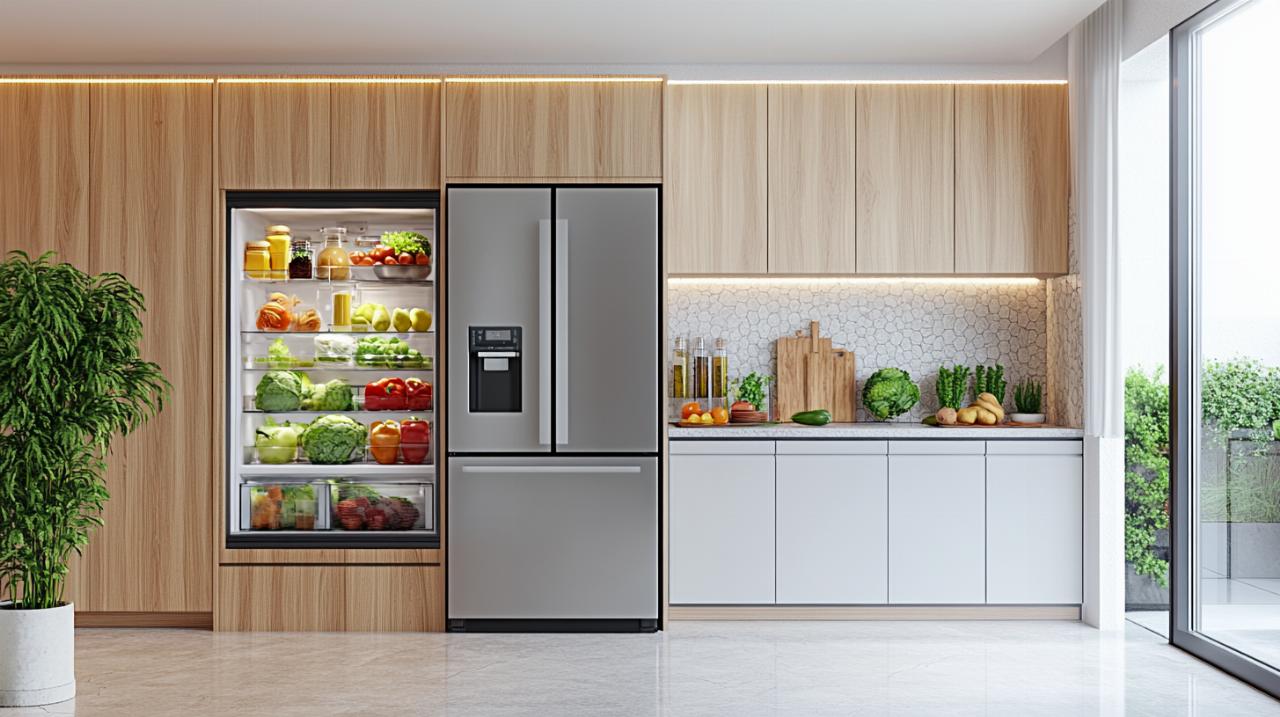The decision to invest in an American-style fridge freezer represents a significant commitment for any household, combining both practical necessity and aesthetic aspiration. These appliances offer generous storage capacity and a striking presence that can transform the heart of your home. However, selecting the right model requires careful consideration of multiple factors, from spatial constraints to long-term running costs. Understanding these elements will help ensure your investment delivers satisfaction for many years to come.
Space and Dimensions: Ensuring a Proper Fit
Measuring your kitchen area accurately
Before falling in love with a particular model, it is essential to assess whether your kitchen can physically accommodate it. American-style fridge freezers are notably larger than their conventional counterparts, typically measuring between seventy and ninety-one centimetres in width, up to seventy-five centimetres in depth, and ranging from one hundred and seventy-seven to one hundred and eighty-nine centimetres in height. This substantial footprint means that precise measurements of your available space are absolutely critical. Take into account not only the width and depth of the intended location but also the height, particularly if you have overhead cupboards or low ceilings. Always consult the appliance manual for exact dimensions, as specifications can vary significantly between manufacturers and models.
Doorway and clearance considerations
Beyond the static dimensions, you must also plan for the dynamic space required when the doors are in use. The full swing of an American fridge door can add up to one hundred millimetres to the appliance's effective width when opened, which is particularly important in narrower kitchens where adjacent cabinetry or walls might obstruct access. Additionally, freestanding models require adequate ventilation to operate efficiently and safely, typically needing between two and five centimetres of clearance around the sides and top. This space allows heat generated by the compressor to dissipate properly, preventing overheating and extending the appliance's lifespan. Check that adjustable feet are available to ensure the unit sits level, and confirm that power outlets are conveniently accessible without requiring awkward positioning or extension leads.
Capacity and storage requirements
Assessing your household's food storage needs
One of the primary attractions of an american fridge for your kitchen is the remarkable storage capacity these appliances provide. Models typically offer over four hundred litres of space, making them ideally suited for larger families or households that prefer to shop less frequently and store more provisions at home. Consider your typical shopping habits and the volume of fresh produce, dairy, meat, and frozen goods you regularly keep on hand. If you frequently entertain guests or prepare meals in advance, the generous capacity can prove invaluable. However, for smaller households or those with limited food storage needs, such a large appliance may represent unnecessary expense and energy consumption.
Internal layout and shelf configuration options
The internal organisation of your chosen fridge freezer can significantly impact its practical utility. Look for models with adjustable shelving that can be reconfigured to accommodate larger items such as party platters or tall bottles. Door storage bins are particularly useful for condiments and beverages, while dedicated compartments for fruit, vegetables, and deli items help maintain optimal freshness. Some premium models feature flexible zoning that allows you to adjust temperature settings for different sections, providing tailored storage conditions for various food types. Consider whether the layout matches your storage patterns and whether you can easily access items stored at the back without excessive rummaging.
Features and functionality
Water and Ice Dispensers: Worth the Investment?
Many American-style models come equipped with integrated water and ice dispensers, delivering chilled water, crushed ice, or ice cubes at the touch of a button. These features undoubtedly add convenience, particularly during warmer months or when entertaining, and eliminate the need for ice cube trays or separate water filtration systems. However, they also introduce additional complexity, requiring a mains water connection and increasing the potential for mechanical issues. Dispensers can also slightly reduce internal storage capacity and may require regular filter replacements, adding to ongoing maintenance costs. Weigh the convenience against these practical considerations and your household's actual usage patterns before prioritising this feature.
Smart technology and additional conveniences
Modern refrigeration technology has advanced considerably, with many models now offering smart connectivity that allows you to monitor and control settings remotely via smartphone applications. Some appliances can alert you to temperature fluctuations, open doors, or required maintenance, potentially preventing food spoilage and costly repairs. Other valuable features include No Frost technology, which prevents ice build-up and eliminates the need for manual defrosting, and independent temperature controls for separate compartments, ensuring optimal preservation conditions throughout. Consider which technological enhancements genuinely align with your lifestyle rather than simply opting for the most feature-rich model available.
Energy efficiency and running costs
Understanding energy ratings and long-term savings
Given that your fridge freezer operates continuously throughout the year, energy efficiency should be a paramount consideration. Look for models rated A+ or higher, as these can deliver substantial savings on electricity bills over the appliance's lifespan. An A+ rated fridge uses approximately twenty per cent less energy than a class A model, while A++ models can achieve up to forty per cent greater efficiency. Energy Star certified appliances use at least twenty per cent less energy than standard models, and modern fridges can consume up to fifty per cent less electricity than those manufactured just a decade ago. While more efficient models may carry a higher initial purchase price, the accumulated savings over ten to twenty years of operation often justify the additional investment.

Comparing annual electricity consumption
When evaluating different models, examine the estimated annual electricity consumption figures provided on energy labels. These projections offer a practical basis for comparison and can help you calculate approximate running costs based on your local electricity rates. Remember that actual consumption will vary depending on usage patterns, ambient temperature, and how frequently the doors are opened. Positioning your appliance away from heat sources such as ovens or direct sunlight can further improve efficiency, as can ensuring adequate ventilation clearance around the unit. Over the course of a fridge's typical lifespan of ten to twenty years with proper care, even modest differences in annual consumption can accumulate into significant financial and environmental impacts.
Budget Planning and Value for Money
Setting a realistic price range
American-style fridge freezers represent a considerable financial commitment, with prices ranging from approximately six hundred to over two thousand pounds depending on capacity, features, and brand reputation. Establishing a realistic budget at the outset helps narrow your options and prevents overspending on unnecessary extras. Consider not only the purchase price but also installation costs, particularly if plumbing connections are required for water dispensers, and any modifications needed to accommodate the appliance's size. Some retailers offer attractive financing options or seasonal promotions that can make premium models more accessible, though it is important to factor in any interest charges when calculating the true cost.
Balancing cost against features and quality
While it may be tempting to opt for the cheapest available option, this approach can prove false economy if the appliance fails prematurely or lacks essential features that would improve your daily experience. Conversely, the most expensive model does not necessarily represent the best value if it includes functionality you will rarely use. Seek a balance between upfront cost, anticipated running expenses, and the practical benefits offered by specific features. Well-regarded brands such as Beko, Samsung, Bosch, Balay, Whirlpool, and Teka have established reputations for reliability and innovation. For instance, Beko employs fifty-five thousand workers globally, operates in fifty-seven countries with forty-five production facilities across thirteen nations, and maintains thirty-one research and development centres staffed by more than two thousand three hundred researchers holding over three thousand five hundred international patents. Such commitment to quality and innovation often translates into superior products that justify a slightly higher investment.
Design and aesthetic appeal
Matching your kitchen's style and colour scheme
Beyond functional considerations, your American fridge freezer will serve as a prominent visual element within your kitchen, making its aesthetic appeal an important factor. Consider how the appliance's design will complement your existing décor, cabinetry, and overall kitchen style. Integrated models can be fitted with panels that match your cupboard doors, creating a seamless, built-in appearance that suits contemporary or minimalist interiors. Freestanding units make a bolder statement and offer greater positioning flexibility, allowing you to relocate them if you reconfigure your kitchen layout. Some households prefer the appliance to blend discreetly into the background, while others embrace it as a design feature that adds character and visual interest to the space.
Finish options: stainless steel, matte, and beyond
The external finish of your fridge freezer contributes significantly to its visual impact and practical maintenance requirements. Stainless steel remains a popular choice for its modern, professional appearance and relatively easy cleaning, though it can show fingerprints and smudges that require regular wiping. Matte finishes offer a sophisticated alternative that tends to conceal marks more effectively, while black or white options can provide striking contrast or harmonious blending depending on your kitchen's colour palette. Some manufacturers now offer finishes in bolder colours or textured surfaces that can serve as focal points. Consider not only initial appearance but also how different finishes will age and whether they can withstand the inevitable scuffs and scratches that come with daily use in a busy kitchen.
Brand reputation and customer reviews
Researching manufacturer reliability
The reputation of the manufacturer should factor heavily into your decision, as it often correlates with build quality, after-sales support, and spare parts availability. Established brands with long histories in appliance manufacturing typically offer more comprehensive warranties and better customer service infrastructure. Look for companies that provide substantial guarantees on their products, such as ten-year parts guarantees on large appliances, which demonstrate confidence in their manufacturing standards. Research the manufacturer's track record regarding reliability, innovation, and environmental responsibility. A company's investment in research and development facilities and international patents can indicate ongoing commitment to product improvement and technological advancement.
Reading real user experiences and feedback
While manufacturer specifications and professional reviews provide valuable information, genuine customer feedback offers insights into real-world performance and long-term satisfaction. Browse independent review platforms and retailer websites to read experiences from actual users who have lived with the models you are considering. Pay particular attention to comments regarding reliability, noise levels, temperature consistency, and customer service experiences when issues arise. Look for patterns in feedback rather than focusing on isolated complaints, and consider how long reviewers have owned their appliances before posting their assessments. A fridge freezer that performs well over several years of continuous use offers far better value than one that impresses initially but develops problems within the first few years of ownership.




